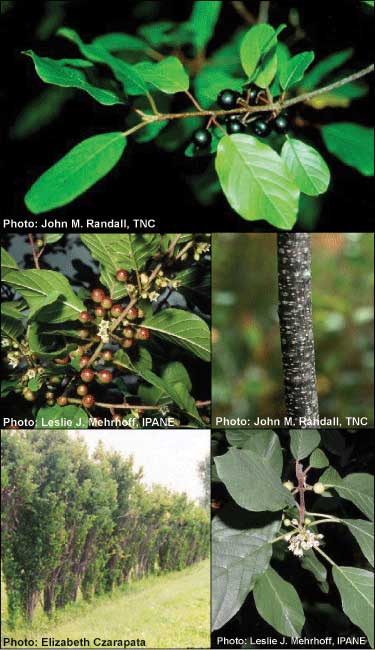Glossy buckthorn (Frangula alnus)
 Synonyms: Rhamnus frangula
Synonyms: Rhamnus frangulaCommon Names: Alder buckthorn, Fen buckthorn, Columnar buckthorn
Description: Rapidly forms dense thickets, crown spreads laterally; resprouts vigorously; had been widely recommended for conservation planting until invasive qualities became apparent.
Habit: Deciduous shrub or small tree growing up to 6 m (20 ft) tall; multiple stems at the base; crown spreading; trunk up to 10 inches in diameter.
Leaves: Simple, alternate, oblong, 2.5-6 cm (1-2.5 in) long; untoothed or crenulate margins; dark green; shiny; smooth or slightly hairy below; veins turn toward tip near leaf margins; leaves present from mid-May to November.
Stems: Brown-green in color, hairy, prominent lenticels, chunky bark, terminal buds rust colored, bark gray or brown in color, sapwood yellow, heartwood pinkish to orange.
Flowers: Small, greenish yellow; four petals; clusters of 2-6; bisexual; blooms late May through September.
Fruit and seeds: Round, pea-sized, drupes of 3-4 seeds, red, ripening to black/dark purple in July through September; abundant; remain viable in the soil for 2 to 3 years.
Habitat: Sun and shade tolerant; occurs in a variety of soil and moisture conditions, from wet to very dry; found in pastures, fence rows, roadsides, wetlands, and woodland edges.
Reproduction: Primarily sexual; plants mature quickly; at any given time there can be flowers, partially ripened fruit (red) and fully ripened fruit (black) on the same plant.
Similar species: Alder buckthorn (Rhamnus alnifolia) is less than 1 m (3 ft) tall, hairless twigs; Lance-leafed buckthorn (Rhamnus lanceolata) is less than 2 m (6 ft) tall, leaves up to 15 cm (6 in) long, tapering.
Monitoring and rapid response: Monitor woodland and wetland edges, and paths; buckthorn leafs out early and retains its leaves late into fall. Begin control efforts in highest quality areas; hand pull seedlings or burn with propane torch where densities are high; target large, fruit-bearing plants for control/removal; treat cut stumps with herbicide; basal bark treatment is also effective. Where fuel is present, prescribed fire may provide effective control of seedlings in fire adapted communities. This species is difficult to control, research control options thoroughly. Credits: The Michigan Natural Features Inventory (MNFI) has partnered with MISIN to provide the information in this fact sheet. Species images and/or information were used with permission from "A Field Identification Guide to Invasive Plants in Michigan's Natural Communities" and "A Field Guide to Invasive Plants of Aquatic and Wetland Habitats for Michigan.
Common Name: | Glossy buckthorn |
Scientific Name: | Frangula alnus |
Family: | Rhamnaceae (Buckthorn) |
Duration: | Perennial |
Habit: | Shrubs |
USDA Symbol: | FRAL4 |
 View Species Course |
|
